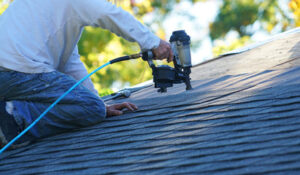Roofers install, repair and replace roofs on commercial buildings, homes and other structures. They often work with shingles, but may also use tile, solar shingles and other materials.

Residential roofers work on single-family homes and must be able to navigate through neighborhoods while accessing rooftops. They also need to be detail-oriented and able to answer homeowners’ questions.
Roofers have a significant impact on the appearance and functionality of buildings. Their work protects people and property from harsh weather elements, while also safeguarding structures from structural damage and enhancing energy efficiency. The quality of a roof depends on the materials used and the workmanship involved. High-quality roofers use top-rated products and adhere to best practices for installation. This ensures that the final product is durable, attractive, and watertight.
Roofers also need excellent customer service skills to interact with customers, answer questions, and address concerns. They must be knowledgeable about roofing materials and techniques, and able to provide customers with options that suit their needs and budget. In addition, roofers often collaborate with other construction professionals, so good communication and coordination is important.
Residential roofers typically work on single- and multi-family homes. They navigate through residential neighborhoods to access rooftops, and they must be mindful of surrounding property when working on the roof. They also need to set up ladders and scaffolding safely, and they must account for all materials used in completing the job.
Commercial roofers work on industrial and commercial facilities, such as schools, hospitals, and warehouses. They may install or repair flat or low-sloped roofs, and they may also install solar panels. These projects require extensive knowledge of building codes, safety regulations, and roofing materials. Commercial roofers also need to communicate effectively with facility managers and other staff members to ensure that the project is completed on time and within budget.
Storm chasers focus on repairing or replacing roofs after severe weather events. They typically target neighborhoods that have recently experienced hail, tornadoes, or high winds. These roofers are paid by the insurance company for their services, so they have a financial incentive to complete the job quickly and correctly. This type of roofer may not offer the same level of customer service as a local or independent roofer.
The reputation of a roofer is an important consideration when choosing a contractor to work on your home or business. Look for a provider with an established history and a solid track record of satisfied customers. Ask potential providers for references and testimonials, and read reviews on sites like Angi and Google. Also, consider the length of their warranties and guarantees. A reputable provider will offer strong guarantees from the manufacturer covering shingles for up to 30 years, as well as a 5-year warranty on their workmanship.
Insurance Coverage
Roofers deal with imminent dangers every day on the job, which makes insurance a non-negotiable part of their business. If they don’t have adequate coverage, a bad mistake could cost them thousands of dollars. In addition to standard liability insurance, contract roofers should also have workers’ compensation and other types of commercial insurance that are designed specifically for their work.
Roofing contractors can save money on their commercial insurance by getting a business owners policy (BOP), which bundles three kinds of coverage into one. This includes general liability, which covers damage caused by your work to third-party property or people (for example, a ladder falling off during a project and breaking a window). It also includes workers’ compensation, which pays medical expenses and lost wages for employees who are injured on the job.
Many states require that employers carry workers’ compensation insurance for their employees. This type of coverage helps pay for immediate and long-term care costs, loss of income, and even death benefits. Typically, a worker can only sue for workers’ compensation if they can show that the employer was negligent in some way. That’s why many roofers only hire reputable contractors who have this coverage.
Other forms of commercial insurance that roofers need include business auto insurance, which is often bundled with commercial general liability, and builders risk insurance, which protects construction projects from damages caused by fire, lightning, wind, and other natural disasters. Lastly, it’s important for roofers to have commercial umbrella insurance that will protect them from claims that exceed their primary policies’ limits.
Roofing contractors should also consider getting new York commercial auto insurance, which provides protection for cars, trucks, vans, and other vehicles that are used in business-related activities. It’s often cheaper than personal auto insurance and can cover a wider range of vehicles. It may also include special coverage for vehicles that are customized with racks and toolboxes. Learn more about the different types of commercial insurance that a roofer should have by talking to a licensed agent or requesting a quote today.
Save Money
A new roof is expensive, but many homeowners are able to save money by choosing high-quality materials. For example, some roofers use energy-efficient shingles that can reduce your home’s heating and cooling costs by up to 30%.
Roofers also may offer a variety of payment options to help customers save. For example, some will accept cash for smaller projects and a bank loan for larger ones. However, it’s important to remember that some roofers require a percentage of the total project cost upfront as a deposit. This is a standard practice for contractors and is meant to ensure that the customer will follow through on their end of the deal.
In addition to helping homeowners save money on their roofing projects, roofers can also help them reduce energy bills by installing a heat-reflective clay roof tile. This type of roofing material helps homeowners cut down on their utility bills by reflecting sunlight instead of absorbing it, which allows the sun to heat the interior of the house more effectively.
Local roofers can also save you money by offering discounts during the off-season. This is because they don’t have to compete with other companies for work during the summer months, when their prices are typically higher.
Another way that roofers can help their customers save is by providing a detailed estimate of the project’s total cost. This helps homeowners understand exactly what they’re paying for and can make negotiating a better price much easier.
Some roofers offer a number of different financing options, including personal loans and HELOCs. While the terms and conditions of these loans vary widely from lender to lender, you can often find a good deal by shopping around.
Finally, a few roofers specialize in insurance work and can help their customers navigate the insurance process. These are called storm chasers, and they tend to target neighborhoods where there’s a high likelihood of storm damage. They’ll usually charge a premium for their services and may not be licensed or insured. They can also be difficult to work with due to their high-pressure sales techniques.
